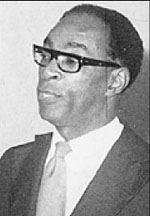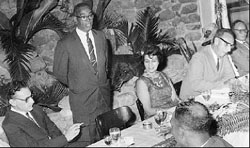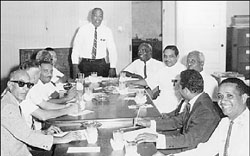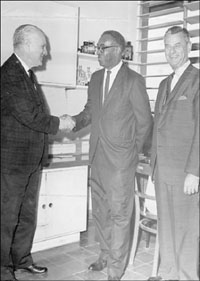|
Famous
Jamaican Scientists
Dreamers Among Us - Prof. Louis Grant,
1913 - 1993
 |
|
1972:
Prof. Louis Grant, chairman of the University Hospital Board and
Professor of Microbiology, UWI, speaking at the official opening
of the School of Physiotherapy.
|
By Dr. Rebecca
Tortello
The saying
"we likkle but we tallawah" can be applied to many aspects
of Jamaican life, not the least of which is Jamaica's contribution to
world science. This article, the first in a two-part series featuring
Jamaican scientists, considers the work of Professor Louis Grant, microbiologist,
one of those whose work had immense local and international impact.
PROF. LOUIS GRANT,
M.D., C.H., M.P.H., DIP BACT., FAPHA, F.C. PATH, F.A.A.N. (1913-1993)
A microbiologist and pathologist, Prof. Louis Grant was affiliated with
the University of the West Indies for 20 years where he achieved the highest
academic honour, being named professor emeritus in microbiology. Young
Louis Grant was surrounded by science from an early age born in
Vere, Clarendon in 1913, his father worked in a chemical laboratory at
the Appleton Estate. As a student, Grant showed promise and received the
Vere Trust scholarship to attend Jamaica College. He went on to Edinburgh
University in Scotland and later specialised in tropical microbiology
at the London School of Tropical Medicine and Hygiene. Prof. Grant then
returned to Jamaica serving his country as a medical doctor, microbiologist
and pathologist.
TUBERCULOSIS
In the 1940s Dr. Grant dreamed of a Jamaica with less disease and he decided
to focus on tuberculosis a disease then plaguing the island. He
asked the World Health Organisation (WHO) and UNICEF for a grant to begin
an inoculation campaign amongst Jamaican children. Joined by Dr. Ronald
Lampart, Dr. Grant completed a mass vaccination that is credited with
helping to break the cycle of infection and halt the spread of the dreaded
disease.
 |
| 1964:
Prof. Louis Grant speaking at a luncheon held by the Society of
Medical Technologists (UWI) at the Flamingo Hotel in honour of his
recent appointment to the new chair of Microbiology at UWI.
|
Groundbreaking
Research On Three Diseases
During the decade of the 1960s, Dr. Grant became a full professor of microbiology
at the University of the West Indies, Mona. Three diseases came to his
attention. Two affected the island's general population and one its horse
population.
LEPTOSPIROSIS
In the early 1960s many Jamaicans began to fall ill with severe fevers.
Some, who seemed otherwise healthy, soon died. Through intensive research
Dr. Grant discovered that this disease was spread through contact with
the urine of infected animals. Rats were immune to it and therefore major
carriers of the virus. Dr. Grant deduced that rats
tend to urinate after eating in kitchens and this way people would consume
food on which rats might have already urinated. There is no cure for viruses,
the most doctors can do is make the patient comfortable while the body
fights off the infection. The leptospirosis virus, if not rejected by
the body immediately on contact, would then enter the blood stream, multiply
and possibly lead to death.
Dr. Grant quickly spread the word, cautioning against rats entering kitchens
and the danger of leaving food exposed. This public education campaign
helped contain the spread of the disease, outbreaks of which have since
been controlled.
EQUINE ENCEPHALITIS
In the mid-1960s, reports of a disease afflicting horses on the eastern
side of the island began to surface. Prof. Grant instituted quarantine
on the movement of horses, donkeys and mules from that region. After much
laboratory investigation he discovered that the horses were suffering
from a virus known as equine encephalitis, which could not be spread to
humans but could cause great damage to Jamaica's horse population. He
recommended further measures for containment, thereby preventing the spread
of the virus and the ruination of Jamaica's billion-dollar horse industry.
He also acquired a new title the horse saviour.
 |
| 1968:
Prof. Louis Grant, centre, vice president of Jamaica Blue Cross, addressing
a meeting of the Board of Trustees of the health plan at headquarters,
Hope Road. Members, clockwise, are Dr. B.A. Shoucair, Dr. M.W. Minott,
Dr. Horace Penso, Dr. C.C. Jones, Mr. Barrington Yee, Mr. Sydney Anderson,
Dr. B.W. Minott, Mr. Hector White, Mr. Douglas Kerr and Mr. Eric Richards.
|
DENGUE FEVER
In the late 1960s Jamaicans
began to suffer from a strange fever. Dr. Grant identified it as the dengue
virus and concluded after much research that it was transmitted via the
aedes aegypti mosquito the same mosquito that carries the
deadly yellow fever virus. This led to another public education campaign
and the beginning of a research effort on the study of arboviruses (viruses
spread by blood-sucking insects) at UWI.
RETIREMENT
In the early 1970s Prof. Grant retired from the University of theWest
Indies and moved to Canada. From 1974 to 1977 he served as the Associate
Medical Officer of Health for the Niagara Regional Health Unit. From 1977
to 1984, he acted as the Medical Officer of Health for the Haldimand-Norfolk
Health Unit. Throughout the decade he spent in Canada, Dr. Grant became
an active member of the Ontario Public Health Association (OPHA) and the
Canadian Public Health Association (CPHA), a community activist and an
advocate for social justice. He gained increasing recognition and was
eventually able to attract large measures of funding to fulfil his lifelong
dream of establishing a public health clinic for low income Jamaicans.
He returned to Jamaica, bringing many international scientists with him
who served at reduced or no cost. His clinic, The Foundation for International
Self-Help (FISH), opened in Papine in 1985. Prof.
Grant died in Jamaica in 1993, leaving behind a wife and four children
and ending a career that spanned 50 years in public service. He had authored
over 90 scientific publications in microbiology and public health and
received the Gleaner Special Award and the Pelican Award in 1985. Prof.
Grant is remembered as the father of Jamaican microbiology. In 1996, an
award in the form of a $1000CD scholarship and one-year membership in
OPHA was established by the OPHA in his honour. The award supports the
postgraduate education of an individual enrolled in a post-graduate programme
in community or public health.
Sources:
Johnson, A. (2001). Great Jamaicans, Book II, Scientists. Kingston: TeeJay
Ltd., www.temos.net/ Reference/quotations.htm, http://www.opha.on.ca/activities/awards/grant.html
 |
| 1967:
Dr. V.A. Cherrington, Professor pf Microbiology and head of the department
of Micro biology at the University of Idaho, shakes hands with Prof.
Louis Grant (centre), head of Microbiology at the University of the
West Indies. Mr. W.C. Cherrington, managing director of Goodyear Jamaica
Ltd., looks on. |
Other
World Class Jamaican Scientists
* Dr. Harold
M. Johnson, 1875-1974. Principal Medical Officer of health who successfully
led the fight against hookworm, ringworm, and malaria in Jamaica.
* Dr. Cicely
Williams, 1893-1992. Identified protein deficiency disease kwashiorkor.
* Dr.
William E. McCulloch, 1896-1963: Found cure for Black Water Fever and
Trypanosomiasis (sleeping sickness)
* Dr. Leigh
D. Lord, 1921 : Blood transfusion pioneer who also developed "Tia
Maria", the world renowned coffee liquor.
* Prof. G. Lalor,
1930 : A physical chemist Prof. Lalor is known for the discovery
of haematoxylin, a substance extracted from logwood and used in the diagnosis
of cancer. Now retired from UWI, he served as a lecturer, creator of UWIDITE,
the system of distance learning, and of Jamaica's first geo-chemical map,
which uncovered many previously unidentified elements. 1974-1995:
He was the Pro-Vice Chancellor of UWI 1991:
Became the second principal of the Mona campus. He remains involved in
various research projects.
* Dr. Kenneth
Richards, 1933 : Developed
the "Richards Procedure" which made lung transplants feasible in humans.
* Dr. Paula
Tennant, 1967 :
A biologist and botanist, she developed the transgenic Jamaican solo sunrise
papaya, which has proven resistant to the Papaya Ringspot Virus in numerous
field testings.
|
| Feedback To the Series |
|
"This is
an absolutely fantastic series. It is critical that we preserve these
for the long term as well as continuing to share with upcoming generations
so that they can understand and feel connected to the past and that it
continues to have some relevance to their future." - Peter,
USA.
"This article
was heartfelt. I moved away from my home country, Jamaica, as a little
girl and have missed out on some of the history that I was to have learned"
- Cadiehead, Jamaica.
"My son is
now learning a great deal about the history of his parents homeland. Please
continue with this fantastic educational site." - Sonia ,
England.
"Keep up the
good works. It's important that these events and people are chronicled,
so that history doesn't die, or get misinterpeted. Remember no history,
no future." - Fabian, Canada.
"Touching,
touching I yet again applaud at how much exposed Jamaica is. Keep writing
these articles they are they main reason I read the newsletters (Go-jamaica)."
- Georgia, USA
"Thoses Proverbs
are great. I remember growing in Jamaica and hearing my grandmother using
some of them." - Richard, Puerto Rico.
"I think
these proverbs are very, very good especially for me who always like my
roots and culture so much. Indeed I appreciate things of like this that
not only educate but keeps one in line with their past. Once again thank
to you all for this great effort. Now I know where to procure educative
information. I am really impressed. Go my Jamaica. " - Motumbo,
Costa Rica
|
| The
First 500 years in Jamaica |
|
We're
taking you for a stroll down memory lane for the next six
months. Along this journey,we will relive several events which
significantly impacted on the social, political and economic
development of Jamaica. As we travel share your experience
with us...
Send your comments to:
Pieces
of the Past,
The Gleaner Company Ltd.,
7 North Street, Kingston;
E - mail us: editor@gleanerjm.com
Fax 922-6223.
|
|
|



